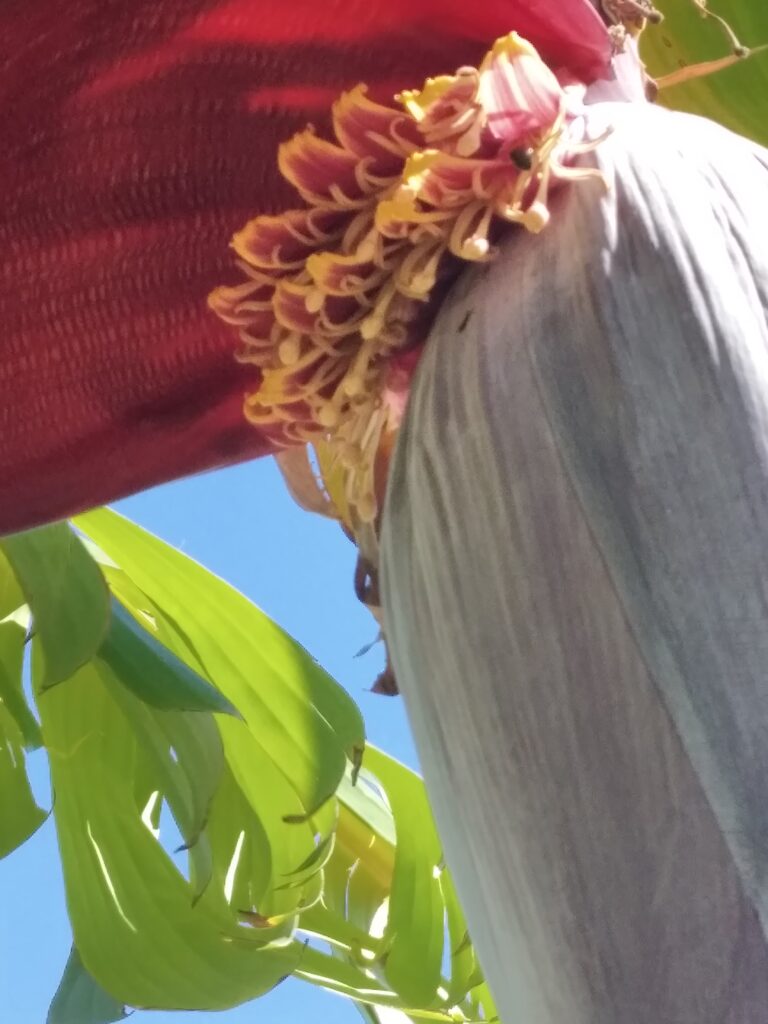
Large, green, leaves on tall trunks make banana plants one of the most beautiful edibles to add to your home garden.
I live in Texas, zone 9, and last year our winter was harsh, dropping ice and snow that lay on the ground for 4 days. I know if you live in the north you would not see this as a harsh winter, but we don’t see snow often, In fact, I can count only 4 snowstorms in my lifetime.
I was sure my banana plant would not make it, as I was young and newly planted. Yet, I wrapped the truck in fabric and covered that in plastic. Lastly, I stacked leaves and pine shavings around the roots as deeply as I could and it worked. My plant not only survived but thrived and this year it flowered and gave me my first bunch of bananas, which are still ripening on the plant.
FLOWERING & FRUITING
Banana flowers usually begin to appear in April – June. However, my plant didn’t flower until late August, maybe due to the cold.
The flowers are produced on a long, pendulous stalk with purple bracts. The first clusters of flowers are all female, and they develop into a fruit.
Once the bunch is set, the flowering stalk will continue to bloom and lengthen, but only male flowers are produced, and no more bananas will form. You may allow the flower stalk to grow or cut it off just below the bunch of developing bananas.
Bananas generally take four to six months for the fruit to reach full size after flowering, depending on temperature, variety, and moisture.
The fruit will look smoother or plumper as it ripens, changing from a square angular shape to a more rounded one.
Fruit should be harvested when full-sized but green because the fruit will often split if left on the plant until fully ripe. You can harvest a cluster at a time or the whole stalk.
Should freezing temperatures threaten your plant, while the bananas are still on the tree, you must harvest the entire bunch whether they are full size or not. Freezing temperatures will ruin your bananas.
Green bananas will ripen after they are picked.
TREE CARE
Banana plants are easy to grow in any soil and are not affected by major insect or disease problems.
Bananas need to be planted in a spot that receives direct sun for at least half a day or more. Also, they are large plants that require plenty of room to spread.
As foliage turns brown, I cut it off and place it under the plant as mulch. This keeps the plant looking good and feeds and protects the roots.
GETTING FRUIT
The main stem of the banana plant is a large rhizome that grows horizontally underground.
The flower stalk of the banana originates from a growing point of the rhizome down at ground level and must grow up through the trunk to emerge from the top among the leaves.
If you are interested in fruit production, do not cut down your trees during the winter when the foliage turns brown. If they survive the winter, the large trunks will produce flowers and fruit the next summer.
Once a banana tree flowers and its fruit has been harvested, you may cut it down to the ground to make room for new, productive trees. Each tree will only flower and bear fruit once.
In my garden, nothing goes to waste. I chopped up the old plant and used it to make feed for my chickens. You can also add it to your compost pile and use mulch.
Follow us on Instagram. Happy Gardening!

